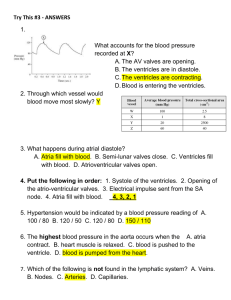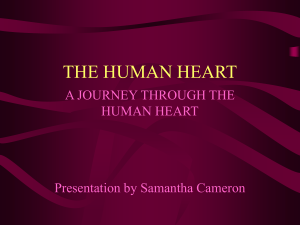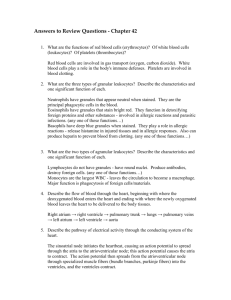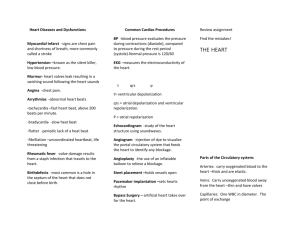The Heart
advertisement
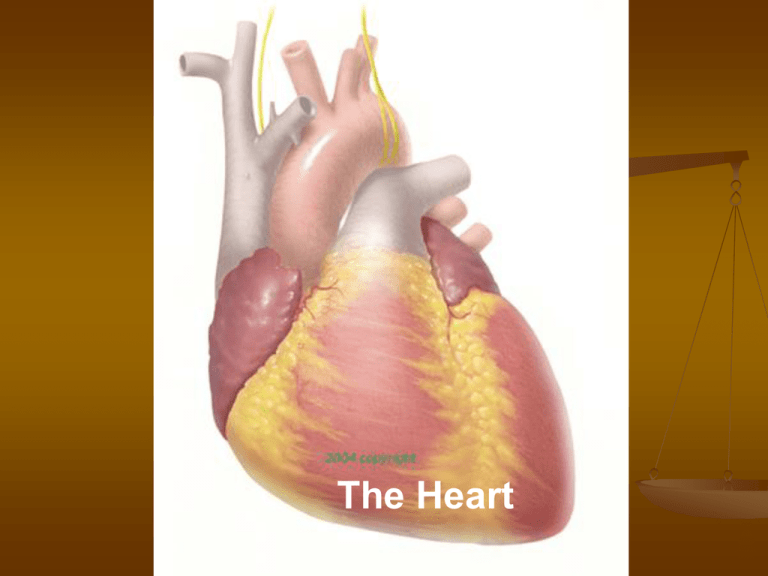
The Heart General Information The heart is the Pump of the Cardiovascular system Located behind the sternum, between the lungs Slightly shifted to the left side of the chest Apex: Points downward Base: (Top) Where all major vessels leave the heart. Size: About the size of your fist BASE APEX Pericardium Membrane surrounding the heart Two Parts: Fibrous Pericardium: Connects directly to heart Dense connective tissue for protection Serous Pericardium: Lines the inner surface of the pericardial sac Pericardial Cavity: Lies between the two pericardial layers Filled with pericardial fluid: Reduces friction between membranes during heart beats Heart Anatomy Two Atria: Two Ventricles: Right and left atrium are receiving chambers Right and left ventricles are pumping chambers Coronary Sulcus: Deep groove that separates atria from ventricles Major Vessels Superior Vena Cava: Returns blood from above the heart to the rt. Atrium Inferior Vena Cava: Returns blood from below the heart to the rt. Atrium. Major Vessels Pulmonary Artery: Delivers Oxygen deficient blood to the lungs, from the rt. Ventricle Pulmonary Veins: Delivers oxygen rich blood to the left atrium from the lungs Ascending Aorta: All oxygen rich blood being pumped from the left ventricle to the systemic circulation Branches into many other major arteries Heart Valves Atrioventricular Valves (cuspid valves): Between atria and ventricles Rt. AV valve: Tricuspid valve (3 flaps) Lt. AV valve: Bicuspid valve (2 flaps) Cordae Tendinae: tendon like cords attached to valves that control blood passage Valves open an close based on pressure differences When pressure within the ventricles increase, valves close Heart Valves Semilunar Valves: Prevent the backflow of ejected blood Pulmonary Semilunar Valve: Between rt. Ventricle and pulmonary artery Aortic Semilunar Valve: Between left ventricle and ascending aorta Heart Wall 3 Layers Epicardium: Very thin outer surface of the heart Myocardium: Muscular wall of the heart Cardiac muscle: Involuntary Endocardium: Inner surface of the heart In direct contact with blood Cardiac Blood Supply Coronary Circulation (Huge blood demand) Lt. And rt. Coronary arteries: arise from ascending aorta All coronary venous return empties into the coronary sinus and empties directly into the rt. Atrium Angina Pectoris: Chest pain due to ischemia (lack of oxygen supply) Myocardial Infarction (MI)/Heart Attack: death of tissue The Heartbeat Conducting System: Heart is self activating The heart has specialized cells that initiate and transmit impulses throughout the heart’s muscular tissue (myocardium) Sinoatrial Valve (SA): in the wall of the right atrium Sets the rhythm/pace of the heart Atrioventricular Node (AV): between atria and ventricles AV bundles, Bundle Branches, and purkinje fibers transmit these impulses throughout the heart The Heartbeat Conducting Pathway: 1. 2. 3. 4. 5. SV Node AV Node AV bundles Bundle Branches Purkinje Fibers Heartbeat Cycle Systole: Contraction Diastole: Relaxation Pathway of Blood Propulsion 1. 2. Atrial systole (blood pumped to ventricles) and ventricular diastole (receive atrial blood) occur at the same time Ventricular systole (pumps blood out of heart) and atrial diastole (receives blood from body and lungs) occur at the same time Heart Murmur Valves do not close properly and blood gets pushed back through valves Can occur at any valve Usually occurs due to faulty cordae tendinae or papillary muscles Heartbeat Dynamics Heart rate (beats/minute) ~ 75 times/min. Blood Pressure: Pressure exerted on vessel walls Read by a sphygnomometer as sounds Measures left ventricle diastole and systole Read systole/diastole Avg. adult male ~ 120/80 Avg. adult female ~ 110/70 What happens if part of the vessels are blocked??? (i.e. atherosclerosis) Electrocardiogram (ECG)/(EKG): Measures electrical events within the heart P wave: Atrial depolarization QRS wave: Ventricle depolarization (masks atrial repolarization) T wave: Ventricle repolarization Heart Sounds Recorded using a stethoscope 1st sound: Lubb 2nd sound: Dubb Caused by the closing of the Atrioventricular valves as the ventricles contract Caused by the closing of the Semilunar Valve as the ventricles relax Murmur: Caused by the swirling and gurgling of blood as it is forced back through valves Cardiac Output Cardiac Output = (Stroke volume) X (Heart rate) CO = 75 bpm X 80 ml/beat CO = 6000 ml/min or 6.0 Liters/minute Cardiac output is altered by either heart rate or stroke volume Elite athletes actually have slower heart rates but increased stroke volumes Both are altered by autonomic nervous system and chemicals within the body

